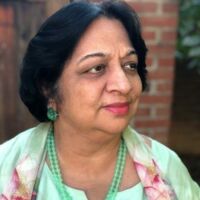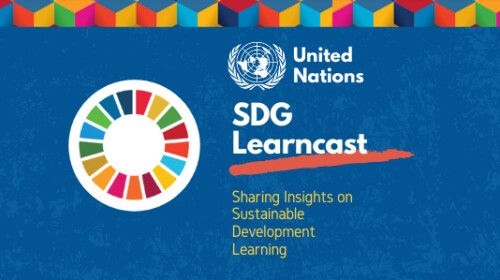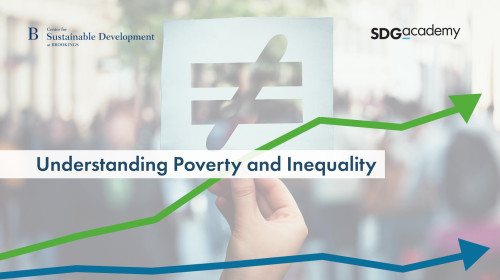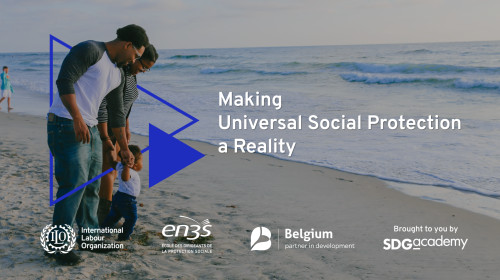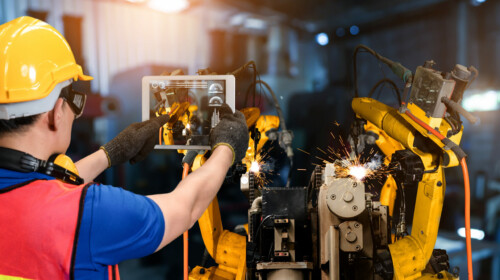According to McKinsey, 45% of the jobs today will be lost in the next 20 years, mostly low-skilled jobs, while the World Economic Forum reports that our skills have a shelf life of 4.5 years. With the World Bank’s twin goal of ending poverty and boosting shared prosperity, how does the Bank uses learning and knowledge exchange to address extreme poverty, lift the bottom 40% of the population, and address SDG gaps in countries?
Let’s hear from Sheila Jagannathan, the Head of the World Bank Open Learning Campus on her perspectives on the changing role of learning, her insights on how we can leverage learning to get back on track post-Covid-19, and how learning can prepare us for the Future of Work. Sheila also authored the book ‘Reimagining Digital Learning for Sustainable Development: How Upskilling, Data Analytics, and Educational Technologies Close the Skills Gap‘.
You can find SDG Learncast on your favorite podcast app.
[Transcript of the podcast]
Paulyn Duman: Welcome to the SDGLearnCast with me Paulyn Duman.
In every episode, I bring you insightful conversations around the subject of sustainable development and learning, helping us all to achieve a sustainable future.
According to the World Economic Forum, the shelf life of skills is 4.5 years and in fact, McKinsey estimates that 45% of the jobs we know today will be lost in the next 20 years, and these will be mostly low skilled jobs. At the same time, there are a number of emerging jobs for which people need to skill themselves continuously, and the COVID-19 pandemic has brought significant challenges in the world of work. In this episode, we will hear from Sheila Jagannathan of the World Bank on how a big organization such as the World Bank prepares for the Future of Work.
Sheila Jagannathan is the Head of the World Bank Open Learning Campus based in Washington D.C. She serves as the organization’s focal on digital learning and issues at the intersection of technology use and education. Sheila is an internationally recognized thought leader and author with over 35 years of experience in leading capacity building, knowledge management, and social learning across public and private organizations. Sheila also provides policy advice and technical assistance to World Bank country-level capacity building programs and for me what I find most interesting is her interest in developing a 60-year curricula, which only shows her commitment to lifelong learning.
I’m sure you want to hear more about Sheila. So who is Sheila Jagannathan of the World Bank and what excites her about the education sector?
Sheila Jagannathan: Hello, I’m Sheila, Jagannathan the Head of the World Bank Open Learning Campus in Washington, DC. Thank you for this opportunity to do a podcast. Let me start with talking about what excites me about working in the education sector. It’s really the opportunity to transform learning and ensure that education is the path to prosperity, leading to employ ability and economic independence, which will have a huge impact on our collective futures.
I also serve as the organization’s focal point and digital learning and issues at the intersection of technology use and education for practitioners in emerging countries. Another interesting part of my job, of course, is to provide policy advice and technical assistance to our country capacity, building programs, both government, and training centers of excellence, seeking to introduce technologies in their educational systems and this could range from East Asia to China, to middle East, not Africa and South Asia as well. Most of all, I’m a lifelong learner.
Paulyn Duman: There is a quote that I really like which says that “Knowledge is one thing that grows when shared.” I think it’s safe to say that a lot of people believe knowledge sharing and learning are one of the key enablers to solving some of the biggest global development challenges.
The World Bank has two main goals: Ending Poverty and Boosting Shared Prosperity. In this episode, Sheila shares with us how the World Bank Group uses knowledge sharing and learn to end poverty, reskill the youth to find jobs relevant for the Fourth Industrial Revolution, deal with climate change, and help countries recover from the Covid-19 pandemic.
We will also hear from Sheila about the World Bank Online Learning Campus or the OLC and the lessons she learned about learning, which includes the end of the role of the teacher as being a Sage on the Stage, but more of becoming a Guide on the Side. She also talks about the big shift from individualized learning to collaborative, where learners interact with peers and experts while being supported by tools and collective intelligence. And we will also hear about her insights during the pandemic and how these insights also influence the work of the World Bank.
Sheila can you tell us more about the World Bank Open Learning Campus, which you are heading?
Sheila Jagannathan: It is the learning ecosystem of the World Bank Group. A sort of go-to destination for development, learning for both staff, as well as World Bank, clients, and partners. We launched the OLC in 2005, and this proved very useful during COVID, as we were able to leverage our investments in digital and blended learning almost immediately and pivot to fully virtual learning on world bank, group priorities, which include COVID-19 responses on economic recovery, on healthcare, sanitation, social protection infrastructure, and so on.
So why did the World Bank create the OLC? And what is the vision? Knowledge, in particular learning, is key to solving development challenges and meeting the World Bank group’s twin goals of ending poverty and boosting shared prosperity? Whether it’s helping countries recover from the COVID pandemic, dealing with climate change, reskilling youth to find jobs relevant for the fourth industrial revolution, or even designing cost-effective health systems, these are often characterized by multiple interdependent challenges and factors. Mitigating these requires change that can be harnessed through continuous learning, not just any learning, but learning continuously by providing dynamic learning opportunities by diverse audiences can learn at their own pace and flexibly access the knowledge and learning they need.
The OLC equips development practitioners and individuals with the knowledge and capabilities to tackle the toughest development challenges. Technology is also changing the learning landscape and the way we learn, teach, assess, and measure. So the Open Learning Campus was launched as a world-class leading destination with two objectives: where staff, World Bank staff learn continuously to stay cutting edge on technical, operational business and leadership skills, and also a place where staff learn together with clients in often in intact teams to co-create solutions, to development, challenges, like urban development, climate change, and so on.
An interesting part of the OLC is to cater to the needs of a busy practitioner. So the results of OLC in the short time, we have been in existence has been significant. On the client learning side. I can say that we have flipped from doing 95% of our training using face-to-face and in-person approaches to 95% digital and blended. And today during COVID, it’s 100% virtual. The evaluations and reactions we’ve heard from learners are also good and we’re continuously taking feedback and improving our systems. So in one sense, OLC has enabled us to move from more traditional ways of teaching and learning to more digital and blended and also cutting edge. So we’ve moved from face-to-face to digital and blended. We’ve moved from more conceptual learning to solutions-focused and embedded. We’ve moved from a purely one-way lecture type of approach to interactive and participatory. And also in terms of learning analytics, we’ve moved from anecdotal to evidence-based. I want to end this question by also mentioning that OLC thrives on strong internal partnerships as well as external partnerships.
Paulyn Duman: How big is the challenge of ending poverty and boosting shared prosperity, and what does that even mean? The World Bank defines extreme poor as those living on less than 1.90 USD a day. How many people are living below 1.90 USD a day? In 2017, the World Bank reported that there are 689 million people living on less than 1.90 USD a day. In 2018, they reported that four out of five people below the international poverty line live in rural areas.
Although global poverty continued to decrease up to 2017, in some regions, up to 2018 and 2019, the World Bank recently updated their estimates to see the impact of Covid-19 on global poverty, and using the January 2021 forecasts, the World Bank now expects that there will a rise to between 119 and 124 million Covid-19-induced new poor in 2020.
For me, the World Bank’s shared prosperity is a very interesting concept. Shared prosperity focuses on the poorest 40 percent of a population. It is defined as the annualized growth rate of their mean household per capita income or consumption. Basically, if there is a rise in the income or consumption of the poorest 40% of the population, then these are important indicators for inclusion and well-being and correlates with reductions in poverty and inequality.
It’s very interesting for me that the World Bank has almost 16,000 staff globally working on achieving these two goals of eliminating poverty and boosting shared prosperity and I got curious how the World Bank ensures that staff share knowledge and learn together and at the same time work together with different partners from different countries that the World Bank services. So I asked Sheila, how the World Bank uses learning to achieve its goals and address SDG gaps at the country level. Let’s hear from her.
Sheila Jagannathan: The short answer is that the OLC is engaged with subject experts and practitioners in the World Bank’s global practices, as well as the practice groups to package and disseminate learning and capacity-building programs around most SDG themes.
We are organized with four large practice groups. For example, there is a whole group called the equitable growth finance and institutions EFI, and here they deal with specific global practices, such as governance and poverty and equity, and so on. Another group that we have is a practice group that we have is human development, which deals with education, gender, health, nutrition, and poverty social protection, and so on. And a third large bucket, a practice group is sustainable development, which deals with climate change, agriculture environment, urban, rural, and social, water. And the fourth and last practice group is infrastructure, which deals with energy, transport, public-private partnerships, and so on.
So as you can imagine most of the SDG gaps or goals are covered through these large practice groups and the global practices within them and the OLC works with almost all of the global practices to disseminate the knowledge and flagship reports that they are designing in easily accessible ways. Operational teams to come together, to learn from each other, to learn from global experts in identifying and scaling up innovative tools, technologies, approaches to whatever the training is about. So in a nutshell, we work, the OLC works with the global practice of the World Bank Group to sort of package and make more accessible most of the topics that are related to the SDGs.
Paulyn Duman: The idea of establishing practice groups to ensure the dissemination of information but also building capacity development programmes is very interesting and very useful. Since Sheila has been working in the learning sector for more than 35 years, I was interested to know what are some of the key lessons on the most effective methodologies and processes around learning for sustainable development.
Sheila Jagannathan: So I’d like to start by saying that one unique element about development learning, as opposed to corporate learning or even academic learning, is that most of the learners that come to OLC are often experts themselves, mayors development, practitioners, regulators, and so on. And therefore, most of the pedagogy we use has to respect this, that we’re not dealing with young adults or children, but we’re dealing with people who have a vast amount of expertise themselves. So some of the principles that have worked well for us is, one, creating a collaborative space to enable the learners. Most often the practitioners who come to OLC to ask questions, to share tacit knowledge, to benefit from the experience of their peers in that class.
Two, our programs are focused on solutions, which systematically capture and mobilize practical insights and solutions on what works and what doesn’t. And this is shared in, in an engaging manner. The third is that we’re moving away from lectures to more learner-centric activities like role-plays quizzes, peer reviews, scenario analysis, reflections, and so on to make our webinars, our courses, our MOOCs, more interactive and participatory. Fourth, most of our learning focuses on real-world problems to help the learners apply and integrate development concepts within practical applications. Really experiential learning, if you will and this is done through cases, problem sets, guided inquiry, learning labs, and so on.
Fifth, multichannel and game infused so we try to leverage as many available channels such as face-to-face virtual classrooms, social networking, mobile technology, to promote a continuous and connected learning experience, and this, in turn, strengthens interactivity collaboration and applied problem-solving.
And of course, many of our courses are facilitated by experts, both international world bank experts, regional and at the country level. So for us digital learning, doesn’t eliminate the human. A human expert is very much part of the learning experience. And finally, we use data and learning analytics to improve get feedback and integrated it into our future offerings.
Paulyn Duman: What do you think is the future of learning?
Sheila Jagannathan: Rethinking the learning and capacity building agenda is very, very relevant today because of some opportunities, but also some challenges that the world is facing. Notably, it is the ongoing digital transformation, or fourth industrial revolution as it’s called, which changes the nature of work and the stability of jobs and careers, and requires lifelong learning as the new normal.
In fact, McKinsey estimates that about 45% of the jobs that we know of today will be lost in the next 20 years and these will be mostly low-skilled jobs. But also at the same time, there will be many, many emerging job opportunities for people who skilled themselves continuously. Equally significant are the multiple challenges the world is facing today, including the COVID pandemic, which has pivoted the entire global community to virtual work and learning.
Also, the SDGs that have to be achieved by 2030, the youth bulge, climate change, and so on. So here, I would like to make a point that given the scale of the challenge of massive re-skilling and up-skilling needed, digital learning has to be a part of the mix, this cannot be met by face-to-face approaches alone. But also here, I would like to make a mention that learning as a sector is fundamentally changing and disrupting the way we learn the way we teach, the way we credentialize, the way we assess the way we support them. Let me give you a few examples.
So first learning is moving away from being in one phase of our lives to continuous and lifelong. So in the old economy, life existed in three blocks. You educate yourself for the first 20 years, your work for the next 40 years, and then you retire and lifespan was 73 years old.
Today people are living much longer than 90 years. The shelf life of skills is 4.5 years, according to the World Economic Forum. And the learning block is now lifelong because you have to move in and out of work, learning retooling, and maybe retired well into your eighties. And so learning has to be continuous.
Second, learning is not focused anymore, just on formal courses, but it’s more holistic and encompassing formal, informal peer learning on the job and so on. Third lecture base models are giving way to more experiential models, relying on flipped classroom and social learning, and so on.
In this context, the role of the teacher and learner are changing. The teacher is no longer a Sage on the Stage, but a Guide on the Side, trying to guide and facilitate active learning by effectively utilizing a number of tools, including digital tools and resources. Similarly, the role of the learner is also moving from more individualized to collaborative, where the learner interacts with peers and experts and is supported by tools, facilitating collective intelligence and crowdsourcing and co-creation.
Five, we’re moving away from learning silos of learning, just one sector to more cross-sectorial and hybrid and these are particularly important in SDG where the overall development impact sought to be accomplished are often cross-sectoral in nature.
And as we move to lifelong learning, learning itself is becoming more modular, especially modular credentialing. So instead of having large four-year degrees, there is talk about unbundling into simpler modular approaches and academic institutions are also moving to create flexible, shorter degrees, and also shorter specializations, such as micro-credentials certificates, badges, Micro Masters, so that you’re able to throughout your life, attain these certificates and stack them one on top of the other.
So that’s how learning is changing. And I think post-COVID, it will be, will not return to largely face-to-face types of approaches. It’s definitely going to be blended and hybrid.
Paulyn Duman: As a final question, I asked Sheila how can we use learning to Build Back Better after this Covid-19 pandemic, and some people are talking about Build Forward Better, but really the question is how can we get back on track?
Sheila Jagannathan: Let me talk about five to six key thoughts here. COVID has really given us an opportunity to take a break and pause and to reimagine and architect a new and better future for learning. Let me share a few lessons and pointers.
One it is important to lead with a mindset shift that is agile and forward-looking to get new results. Usually, when we adapt to new technology, such as a webinar, we do exactly what we would have done in a traditional classroom and this is what we want to avoid. We should use new technologies and new ways to get the new value that we didn’t get before.
Number two, blended learning is going to be the new normal and Anant Agarwal who heads the eDx at MIT and Harvard says that post-COVID 40 to 50% of online activities will co-mingle with in-person activities after the pandemic is over. So, what we should really do is normally we start with the default of face to face and then add a few online, and what I think post COVID we should be doing is start with the default of online and add face-to-face where it becomes useful.
Three, evidence-based pedagogy and engagement strategies are critical. Good learning design can really overcome digital fatigue and create the motivation we want. So I think we should use a number of different participatory and engaging approaches and also learn from neuroscience principles, which talks about many different techniques to support retention, but also the importance of repetition and spacing out learning and so on and so forth. So the bottom line is pedagogy becomes very, very important.
Four, I talked about it earlier but stressing here. Connected learning is key. You ask a number of people, what they miss about online learning. They say they miss the connection with experts and peers and so we need to build this in the digital learning new generation of digital learning that we’re designing, including a presence of a human expert, guiding coaching, and mentoring.
Five, artificial intelligence is, is going to play a very key role and so we should pay close attention to how this is developing as it can help in many ways throughout the learning cycle from creating learning engagement to feedback, to content and curation. And most of all, to create, not a one-size-fits-all, but personalized individual tracks for the learner, which leads them to greater success in achieving the learning outcomes.
Six, data is the new currency of learning and development, and given that there is a digital footprint in all of the blended and digital learning, we do, it’s important to leverage this. You know, the feel-good statistics like completion metrics and so on are no longer relevant. We, I mean, I don’t mean to say they’re no longer relevant, they can’t be the only tool we use for evaluation. We should use learning analytics to collect, analyze, and report data or about learners while they’re learning so we can enhance the overall effectiveness of the learning experience. And here, I would say start small and then build out after that.
And final point is that staff wellness is key to productive work. We have realized this during COVID and as leaders of learning, it is very important to keep this in mind and provide opportunities to address these challenges.
Paulyn Duman: Thank you so much, Sheila.
Sheila Jagannathan: It’s been a great pleasure to join you in this podcast. Thank you for inviting me.
Paulyn Duman: And that was Sheila Jagannathan of the World Bank Open Learning Campus. There were so many lessons that we can take away from Sheila’s experience but let me share mine with you. One of the highlights for me is the changing role of teachers, from being a sage on the stage to being a guide on the side, hence the title of this episode. We also learned that learning for learners is also shifting from being individualized to more collaborative learning.
We also heard but also experience that digital technologies are even more important and with our skills having a shelf life of around 4.5 years, upskilling and reskilling will be crucial for all of us. If we look at what learning would look like post-pandemic, it will be blended learning, or a combination of face-to-face and online components.
But one thing we learned is that, although a lot of continuous learning will take place online, connected learning is still critical. When people are asked what they missed in online learning, it is that connection with experts and peers, that element of social, that they miss the most. The presence of human persons as a guide, a mentor, and as a peer has gotten even more significant. We are social animals after all.
You can find more of the SDGLearnCast on the UN SDG:Learn website. For now, I’m Paulyn Duman. Thanks for listening.
Paulyn Duman is the Knowledge Management, Communications, and Reporting Officer at the UNSSC Knowledge Centre for Sustainable Development and is a coordinator for the Joint Secretariat of UN SDG:Learn, together with UNITAR.
The opinions expressed in the SDG Learncast podcasts are solely those of the authors. They do not reflect the opinions or views of UN SDG:Learn, its Joint Secretariat, and partners.

